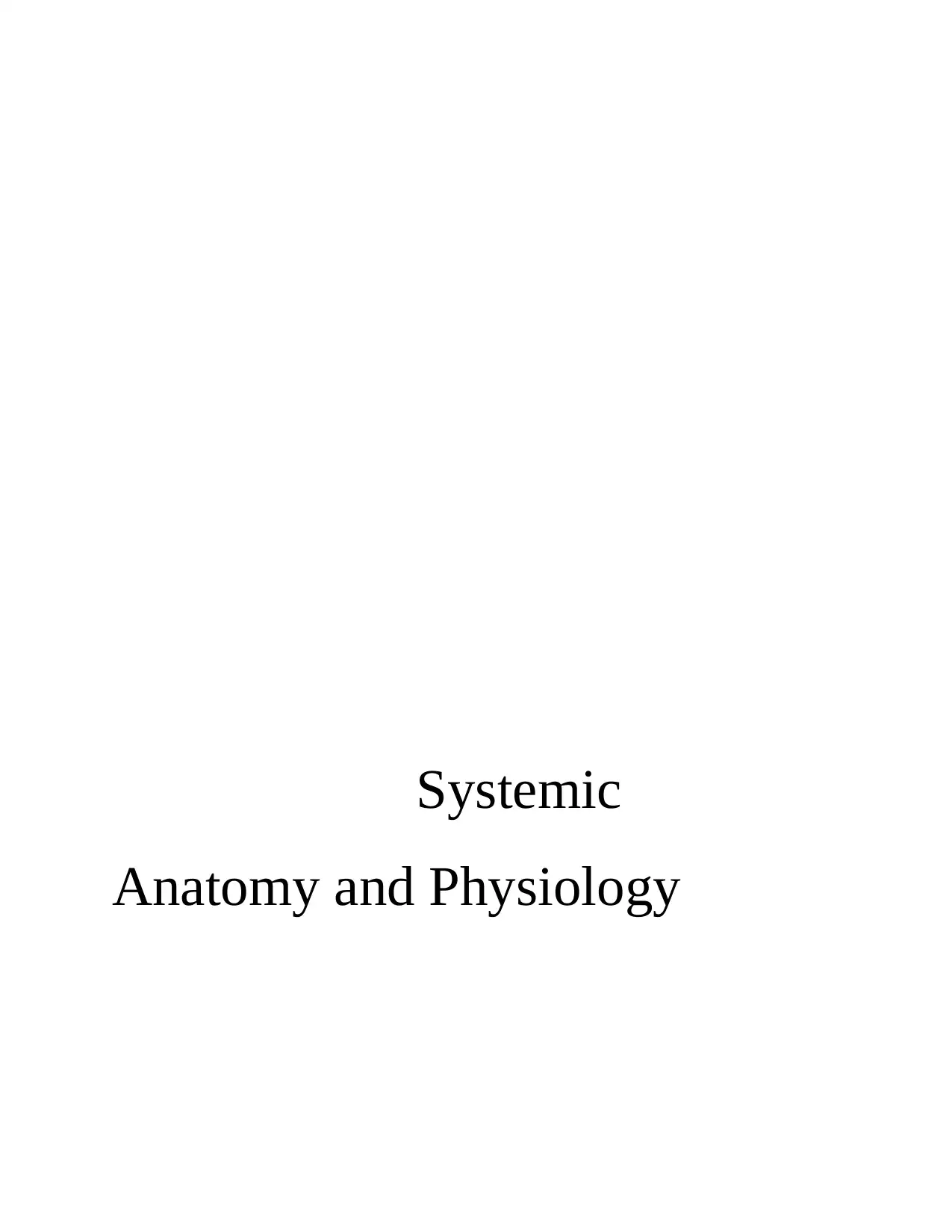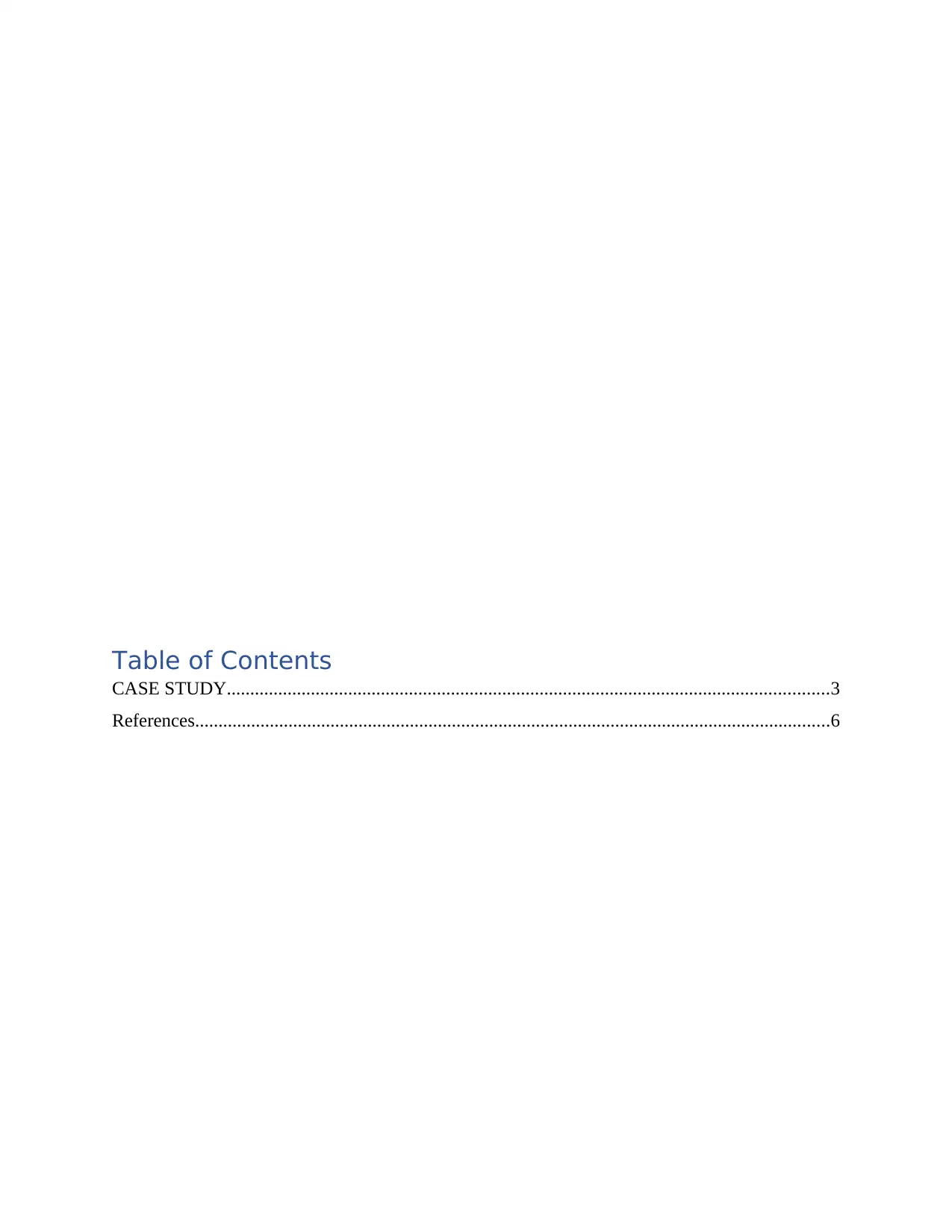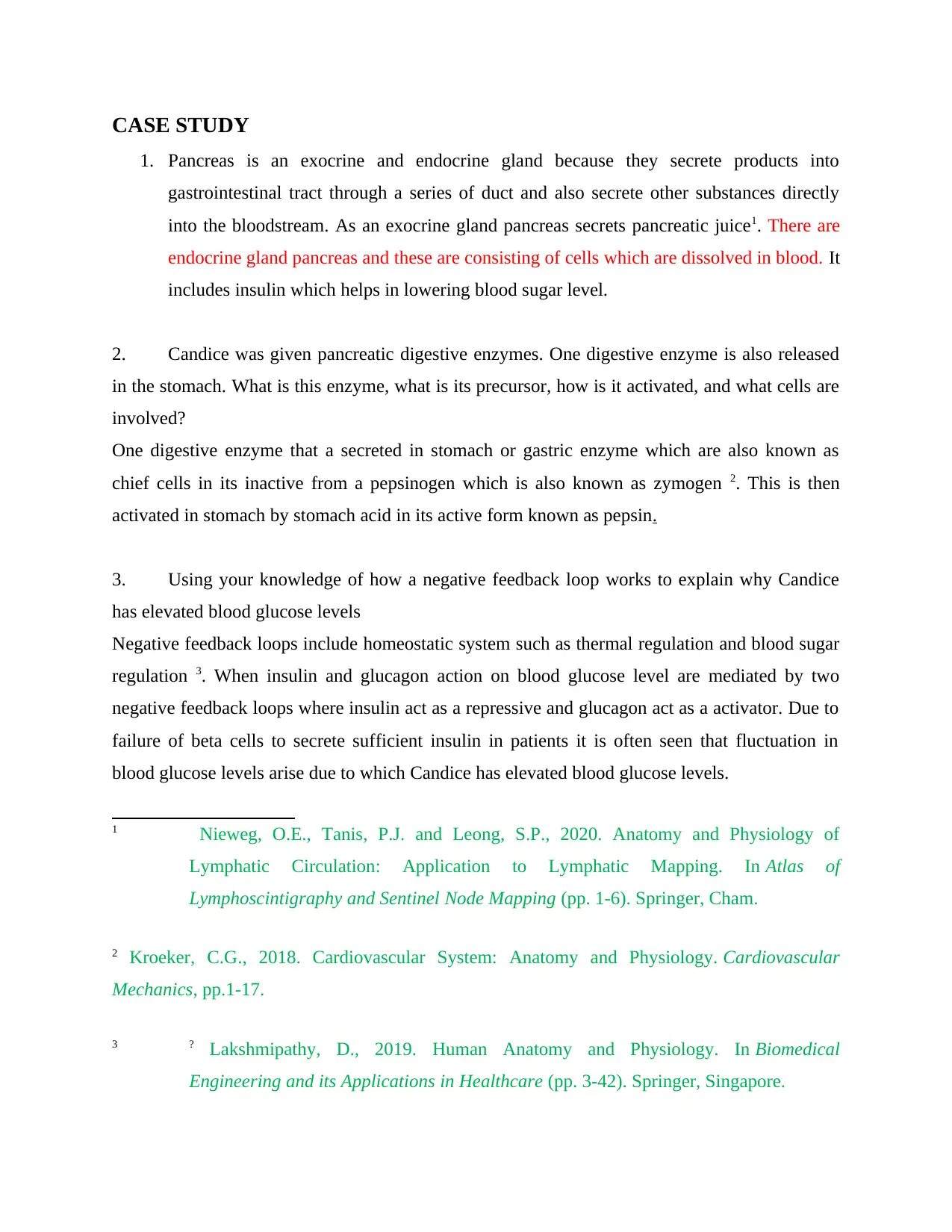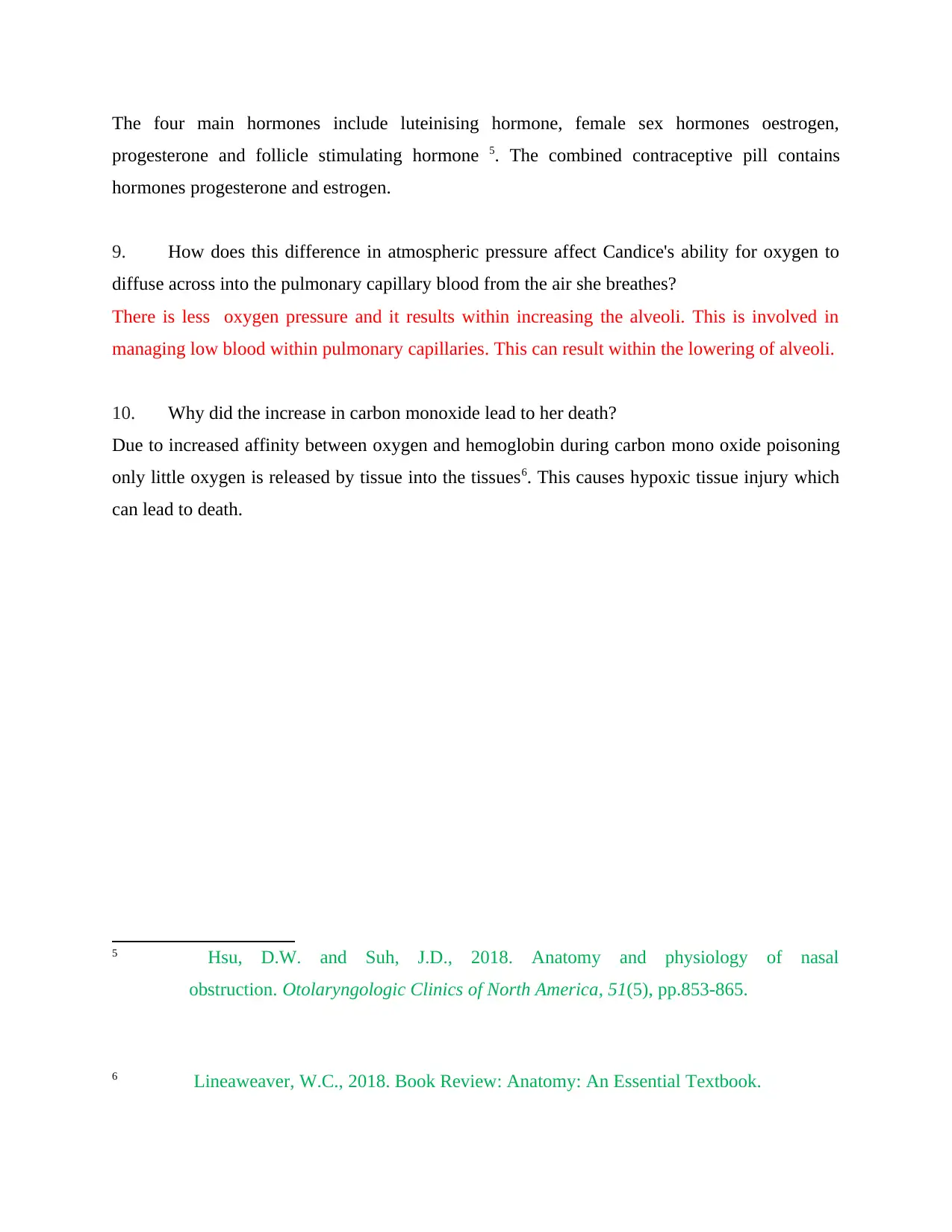Anatomy and Physiology: Case Study
VerifiedAdded on 2023/01/06
|6
|1039
|27
AI Summary
This document is a case study on anatomy and physiology, covering various topics such as pancreatic enzymes, blood glucose levels, ECG results, cardiovascular factors, angiotensin II, glomerular filtration rate, hormones in the uterine and ovarian cycle, atmospheric pressure, and carbon monoxide poisoning.
Contribute Materials
Your contribution can guide someone’s learning journey. Share your
documents today.

Systemic
Anatomy and Physiology
Anatomy and Physiology
Secure Best Marks with AI Grader
Need help grading? Try our AI Grader for instant feedback on your assignments.

Table of Contents
CASE STUDY.................................................................................................................................3
References........................................................................................................................................6
CASE STUDY.................................................................................................................................3
References........................................................................................................................................6

CASE STUDY
1. Pancreas is an exocrine and endocrine gland because they secrete products into
gastrointestinal tract through a series of duct and also secrete other substances directly
into the bloodstream. As an exocrine gland pancreas secrets pancreatic juice1. There are
endocrine gland pancreas and these are consisting of cells which are dissolved in blood. It
includes insulin which helps in lowering blood sugar level.
2. Candice was given pancreatic digestive enzymes. One digestive enzyme is also released
in the stomach. What is this enzyme, what is its precursor, how is it activated, and what cells are
involved?
One digestive enzyme that a secreted in stomach or gastric enzyme which are also known as
chief cells in its inactive from a pepsinogen which is also known as zymogen 2. This is then
activated in stomach by stomach acid in its active form known as pepsin.
3. Using your knowledge of how a negative feedback loop works to explain why Candice
has elevated blood glucose levels
Negative feedback loops include homeostatic system such as thermal regulation and blood sugar
regulation 3. When insulin and glucagon action on blood glucose level are mediated by two
negative feedback loops where insulin act as a repressive and glucagon act as a activator. Due to
failure of beta cells to secrete sufficient insulin in patients it is often seen that fluctuation in
blood glucose levels arise due to which Candice has elevated blood glucose levels.
1 Nieweg, O.E., Tanis, P.J. and Leong, S.P., 2020. Anatomy and Physiology of
Lymphatic Circulation: Application to Lymphatic Mapping. In Atlas of
Lymphoscintigraphy and Sentinel Node Mapping (pp. 1-6). Springer, Cham.
2 Kroeker, C.G., 2018. Cardiovascular System: Anatomy and Physiology. Cardiovascular
Mechanics, pp.1-17.
3 ? Lakshmipathy, D., 2019. Human Anatomy and Physiology. In Biomedical
Engineering and its Applications in Healthcare (pp. 3-42). Springer, Singapore.
1. Pancreas is an exocrine and endocrine gland because they secrete products into
gastrointestinal tract through a series of duct and also secrete other substances directly
into the bloodstream. As an exocrine gland pancreas secrets pancreatic juice1. There are
endocrine gland pancreas and these are consisting of cells which are dissolved in blood. It
includes insulin which helps in lowering blood sugar level.
2. Candice was given pancreatic digestive enzymes. One digestive enzyme is also released
in the stomach. What is this enzyme, what is its precursor, how is it activated, and what cells are
involved?
One digestive enzyme that a secreted in stomach or gastric enzyme which are also known as
chief cells in its inactive from a pepsinogen which is also known as zymogen 2. This is then
activated in stomach by stomach acid in its active form known as pepsin.
3. Using your knowledge of how a negative feedback loop works to explain why Candice
has elevated blood glucose levels
Negative feedback loops include homeostatic system such as thermal regulation and blood sugar
regulation 3. When insulin and glucagon action on blood glucose level are mediated by two
negative feedback loops where insulin act as a repressive and glucagon act as a activator. Due to
failure of beta cells to secrete sufficient insulin in patients it is often seen that fluctuation in
blood glucose levels arise due to which Candice has elevated blood glucose levels.
1 Nieweg, O.E., Tanis, P.J. and Leong, S.P., 2020. Anatomy and Physiology of
Lymphatic Circulation: Application to Lymphatic Mapping. In Atlas of
Lymphoscintigraphy and Sentinel Node Mapping (pp. 1-6). Springer, Cham.
2 Kroeker, C.G., 2018. Cardiovascular System: Anatomy and Physiology. Cardiovascular
Mechanics, pp.1-17.
3 ? Lakshmipathy, D., 2019. Human Anatomy and Physiology. In Biomedical
Engineering and its Applications in Healthcare (pp. 3-42). Springer, Singapore.

4. Candice’s ECG results were normal. How does the P wave, QRS complex and T wave
relate to the conduction system of the heart,
Atrial depolarisation is used by P wave for managing the ventricular depolarisation. The context
of T wave consists of ventricular contraction as well as signals which are used for managing the
relaxation 4.
5. List the cardiovascular factors that affect blood pressure
The cardio vascular factors which are affecting blood pressure to increase include cardiac output,
volume of blood, managing the peripheral resistance of vascular muscles as well as vessel wall
rigidness. Decline of blood and elasticity results within vessel walls.
6. Describe how angiotensin II controls blood pressure, and why an A2RA would reduce
Candice’s blood pressure.
Angiotensin II is involved in controlling individual’s blood pressure. There are different factors
like vasoconstriction, nervous stimulation and enhancement of aldosterone biosynthesis and
renal action. A2RA reduces high blood pressure by affecting angiotensin to receptor antagonist.
It is also marked for reduction of stroke morbidity and mortality among patients who are facing
high blood pressure levels.
7. Hypertension has been associated with reduced glomerular filtration rate. Define
glomerular filtration rate (GFR) and describe the pressures within the glomerular capsule that
affect GFR.
Glomeruler filtration rate refers to glomerulus flowing within body which is present in Bowman
region of kidney and it is required for proper functioning (Lineaweaver, 2018). Capsule consists
of hydrostatic pressure. There are other factors like osmotic pressure which affects membrane
side and glomerular capillary increment.
8. There are four main hormones in the uterine and ovarian cycle – what are they and what
is their role? Which of these are found in the combined pill (as prescribed to Candice) and how
can she use the combined contraceptive pill to prevent menstruation on her climb?
4
relate to the conduction system of the heart,
Atrial depolarisation is used by P wave for managing the ventricular depolarisation. The context
of T wave consists of ventricular contraction as well as signals which are used for managing the
relaxation 4.
5. List the cardiovascular factors that affect blood pressure
The cardio vascular factors which are affecting blood pressure to increase include cardiac output,
volume of blood, managing the peripheral resistance of vascular muscles as well as vessel wall
rigidness. Decline of blood and elasticity results within vessel walls.
6. Describe how angiotensin II controls blood pressure, and why an A2RA would reduce
Candice’s blood pressure.
Angiotensin II is involved in controlling individual’s blood pressure. There are different factors
like vasoconstriction, nervous stimulation and enhancement of aldosterone biosynthesis and
renal action. A2RA reduces high blood pressure by affecting angiotensin to receptor antagonist.
It is also marked for reduction of stroke morbidity and mortality among patients who are facing
high blood pressure levels.
7. Hypertension has been associated with reduced glomerular filtration rate. Define
glomerular filtration rate (GFR) and describe the pressures within the glomerular capsule that
affect GFR.
Glomeruler filtration rate refers to glomerulus flowing within body which is present in Bowman
region of kidney and it is required for proper functioning (Lineaweaver, 2018). Capsule consists
of hydrostatic pressure. There are other factors like osmotic pressure which affects membrane
side and glomerular capillary increment.
8. There are four main hormones in the uterine and ovarian cycle – what are they and what
is their role? Which of these are found in the combined pill (as prescribed to Candice) and how
can she use the combined contraceptive pill to prevent menstruation on her climb?
4
Secure Best Marks with AI Grader
Need help grading? Try our AI Grader for instant feedback on your assignments.

The four main hormones include luteinising hormone, female sex hormones oestrogen,
progesterone and follicle stimulating hormone 5. The combined contraceptive pill contains
hormones progesterone and estrogen.
9. How does this difference in atmospheric pressure affect Candice's ability for oxygen to
diffuse across into the pulmonary capillary blood from the air she breathes?
There is less oxygen pressure and it results within increasing the alveoli. This is involved in
managing low blood within pulmonary capillaries. This can result within the lowering of alveoli.
10. Why did the increase in carbon monoxide lead to her death?
Due to increased affinity between oxygen and hemoglobin during carbon mono oxide poisoning
only little oxygen is released by tissue into the tissues6. This causes hypoxic tissue injury which
can lead to death.
5 Hsu, D.W. and Suh, J.D., 2018. Anatomy and physiology of nasal
obstruction. Otolaryngologic Clinics of North America, 51(5), pp.853-865.
6 Lineaweaver, W.C., 2018. Book Review: Anatomy: An Essential Textbook.
progesterone and follicle stimulating hormone 5. The combined contraceptive pill contains
hormones progesterone and estrogen.
9. How does this difference in atmospheric pressure affect Candice's ability for oxygen to
diffuse across into the pulmonary capillary blood from the air she breathes?
There is less oxygen pressure and it results within increasing the alveoli. This is involved in
managing low blood within pulmonary capillaries. This can result within the lowering of alveoli.
10. Why did the increase in carbon monoxide lead to her death?
Due to increased affinity between oxygen and hemoglobin during carbon mono oxide poisoning
only little oxygen is released by tissue into the tissues6. This causes hypoxic tissue injury which
can lead to death.
5 Hsu, D.W. and Suh, J.D., 2018. Anatomy and physiology of nasal
obstruction. Otolaryngologic Clinics of North America, 51(5), pp.853-865.
6 Lineaweaver, W.C., 2018. Book Review: Anatomy: An Essential Textbook.

References
Books and Journals
Nieweg, O.E., Tanis, P.J. and Leong, S.P., 2020. Anatomy and Physiology of Lymphatic
Circulation: Application to Lymphatic Mapping. In Atlas of Lymphoscintigraphy and
Sentinel Node Mapping (pp. 1-6). Springer, Cham.
Kroeker, C.G., 2018. Cardiovascular System: Anatomy and Physiology. Cardiovascular
Mechanics, pp.1-17.
Lakshmipathy, D., 2019. Human Anatomy and Physiology. In Biomedical Engineering and its
Applications in Healthcare (pp. 3-42). Springer, Singapore.
Lineaweaver, W.C., 2018. Book Review: Anatomy: An Essential Textbook.
Hsu, D.W. and Suh, J.D., 2018. Anatomy and physiology of nasal obstruction. Otolaryngologic
Clinics of North America, 51(5), pp.853-865.
Books and Journals
Nieweg, O.E., Tanis, P.J. and Leong, S.P., 2020. Anatomy and Physiology of Lymphatic
Circulation: Application to Lymphatic Mapping. In Atlas of Lymphoscintigraphy and
Sentinel Node Mapping (pp. 1-6). Springer, Cham.
Kroeker, C.G., 2018. Cardiovascular System: Anatomy and Physiology. Cardiovascular
Mechanics, pp.1-17.
Lakshmipathy, D., 2019. Human Anatomy and Physiology. In Biomedical Engineering and its
Applications in Healthcare (pp. 3-42). Springer, Singapore.
Lineaweaver, W.C., 2018. Book Review: Anatomy: An Essential Textbook.
Hsu, D.W. and Suh, J.D., 2018. Anatomy and physiology of nasal obstruction. Otolaryngologic
Clinics of North America, 51(5), pp.853-865.
1 out of 6
Related Documents
Your All-in-One AI-Powered Toolkit for Academic Success.
+13062052269
info@desklib.com
Available 24*7 on WhatsApp / Email
![[object Object]](/_next/static/media/star-bottom.7253800d.svg)
Unlock your academic potential
© 2024 | Zucol Services PVT LTD | All rights reserved.





